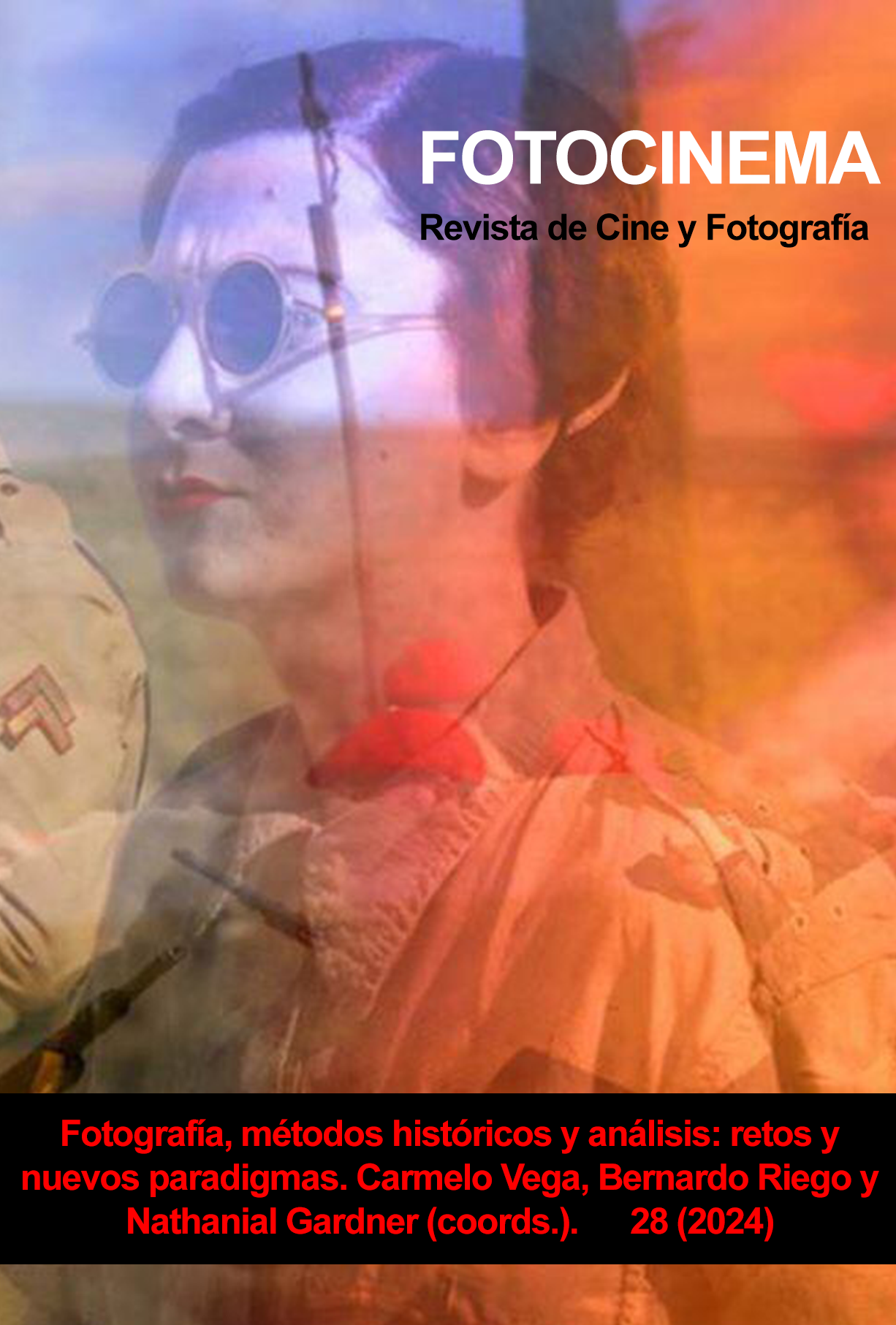Photography, state violence and legibility of history
Notes on the symptom and anachronism of photographic images
DOI:
https://doi.org/10.24310/fotocinema.28.2024.17605Keywords:
Anachronism, symptom, dialectical image, Georges Didi-Huberman, Walter BenjaminAbstract
This paper analyzes photography and its possibility as a device for the legibility of history. To do so, we resort to the concepts of symptom, anachronism (Didi-Huberman) and dialectical image (Benjamin). From these notions we will analyze two photographs that show us the consequences of State violence in Chile. Specifically, the photographs show the dead of the Valparaíso port strike in 1903 and the saltpeter workers murdered at the Santa María School in Iquique in 1907. The starting point is the idea that those images that manage to go beyond the naivety of essences are those visual constructions that manage to establish relations between the visible and the enunciable from a critical point of view and, therefore, manage to configure themselves as a historical index. That is to say, they are images that not only interweave a certain historical time to which they belong and that can shed light on the past, but at the same time are capable of exhibiting and enunciating a regime of historicity, in which the images manifest a link between the social and the historical time of which they are a part.
Downloads
Metrics
Publication Facts
Reviewer profiles N/A
Author statements
Indexed in
-
—
- Academic society
- N/A
- Publisher
- Universidad de Málaga
References
Alloa, E. (2021). La imagen diáfana. Fenomenología de los medios visuales. Ediciones Metales Pesados.
Arendt, H. (2008). Hombres en tiempos de oscuridad. Gedisa.
Arendt, H. (2014). Sobre la violencia. Alianza Editorial.
Agamben, G. (2010). Estado de excepción. Pre-textos.
Bajtin, M. (1989). Teoría y estética de la novela. Taurus
Balandier, G. (1994). El poder en escenas. De la representación del poder al poder de la representación. Paidós.
Barthes, R. (1986). Lo obvio y lo obtuso. Imágenes, gestos, voces. Paidós.
Barthes, R. (2003). La cámara lúcida. Notas sobre la fotografía. Paidós.
Belting, H. (2007). Antropología de la imagen. Katz Editores
Benjamin, W. (2002). La dialéctica en suspenso. Fragmentos sobre la historia. Santiago: LOM Ediciones- ARSIS.
Benjamin, W. (2005). Sobre la fotografía. Pre-Textos, pp. 21-53.
Benjamin, W. (2012). Escritos franceses. Amorrortu Editores.
Benjamin, W. (2016). El libro de los pasajes. Akal
Berger, J. (2006). Modos de ver. Editorial Gustavo Gili.
Blanchot, M. (2002). El espacio literario. Editora Nacional
Bourdieu, P. (2003). Un arte medio. Editorial Gustavo Gili172.
Buck-Morss, S. (2001). Dialéctica de la mirada. Walter Benjamin y el proyecto de los pasajes. La balsa de la medusa.
Collingwood-Selby, E. (2012). El filo fotográfico de la historia. Walter Benjamin y el olvido de lo inolvidable. Ediciones Metales Pesados.
Devés, E. (1997). Los que van a morir te saludan. Historia de una masacre: Escuela Santa María de Iquique, 1907. LOM Ediciones.
Didi-Huberman, G. (2012). Arde la imagen. Ediciones Ve.
Didi-Huberman, G. (2013). Cuando las imágenes toman posición. El ojo de la Historia 1. A. Machado Libros.
Didi-Huberman, G. (2014). Pueblos expuestos, pueblos figurantes. Manantial.
Didi-Huberman, G. (2015a). Ante el tiempo. Historia del arte y anacronismo de las imágenes. Adriana Hidalgo Editora.
Didi-Huberman, G. (2015b). Remontajes del tiempo padecido. El ojo de la historia 2. Editorial Biblos.
Didi-Huberman, G. (2018). La imagen superviviente. Historia del arte y tiempo de los fantasmas según Aby Warburg. Abada Editores.
Dubois, P. (1986). El acto fotográfico. De la representación a la recepción. Paidós.
Flusser, V. (1990). Hacia una filosofía de la fotografía. Editorial Trillas.
Garcés, M. (2003). Crisis social y motines populares en el 1900. LOM Ediciones
Grez. S. (2007). “La guerra preventiva: Escuela Santa María de Iquique. Las razones del poder”. Cyber Humanitatis N°41. https://web.uchile.cl/vignette/cyberhumanitatis/CDA/texto_simple2/0,1255,SCID%253D21038%2526ISID%253D730,00.html#_ftn4
Hillach, A. (2014). “Imagen dialéctica”. En Michael Opitz y Ermunt Wizisla (eds.) Conceptos de Walter Benjamin. Editorial Las cuarenta, pp. 643-708.
Mbembe, A. (2011). Necropolítica. Editorial Melusina.
Ranciére, J. (2005). El inconsciente estético. Del Estante Editorial.
Ranciére, J. (2009). El reparto de los sensible. Estética y política. LOM Ediciones.
Ranciére, J. (2011). El destino de las imágenes. Prometeo libros.
Rojas, S. (2020). “La violencia de los límites en el arte”. Conceição / Conception, 9: 1-17. https://doi.org/10.20396/conce.v9i00.8662157
Sontag, S. (2006). Sobre la fotografía. Alfaguara.
Warburg, A. (2019). La pervivencia de las imágenes. Miluno Editorial.
Yacavone, K. (2017). Benjamin, Barthes y la singularidad de la fotografía. Ediciones Alpha Decay.
Downloads
Published
How to Cite
Issue
Section
License
Copyright (c) 2024 Juan Pablo Silva-Escobar

This work is licensed under a Creative Commons Attribution-NonCommercial-NoDerivatives 4.0 International License.
All contents published in Fotocinema Revista científica de cine y fotografía are protected under the Creative Commons Attribution-NonCommercial-ShareAlike 4.0 International (CC BY-NC-SA 4.0) license. All about this license is available in the following link: <http://creativecommons.org/licenses/by-nc-sa/4.0>
Users can copy, use, redistribute, share and exhibit publicly as long as:
- The original source and authorship of the material are cited (Journal, Publisher and URL of the work).
- It is not used for comercial purposes.
- The existence of the license and its especifications are mentioned.
There are two sets of authors’ rights: moral and property rights. Moral rights are perpetual prerogatives, unrenounceable, not-transferable, unalienable, imprescriptible and inembargable. According to authors’ rights legislation, Fotocinema. Revista científica de cine y fotografía recognizes and respects authors moral rights, as well as the ownership of property rights, which will be transferred to University of Malaga in open access. The property rights are referred to the benefits that are gained by the use or the dissemination of works. Fotocinema. Revista científica de cine y fotografía is published in an open access form and it is exclusively licenced by any means for doing or authorising distribution, dissemination, reproduction, , adaptation, translation or arrangement of works.
Authors are responsable for obtaining the necessary permission to use copyrighted images.














13.png)



